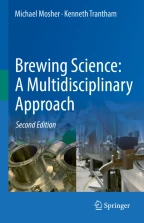
When we think about making beer, what comes to mind? Often we rely on those images with which we’re familiar, the TV ads showing brewers sitting around sampling their work or the server pulling a tap to dispense a beautiful yellow liquid into a glass. But there is more to the process than we see on the television. And the science behind that process is quite interesting. We’ll begin our look into the brewing process from the very beginnings of civilization and build our understanding to the methods used today. Along our journey, we’ll uncover the science behind the scenes and gain a much deeper understanding of this very important beverage.
This is a preview of subscription content, log in via an institution to check access.
eBook EUR 58.84 Price includes VAT (France)
Softcover Book EUR 73.84 Price includes VAT (France)
Hardcover Book EUR 105.49 Price includes VAT (France)
Tax calculation will be finalised at checkout
Purchases are for personal use only
This “experiment” is designed to familiarize you with the standard types of laboratory equipment used in the analysis of beer and its components. This is very useful if you are not familiar with the SI system of units, and serves as very good review if you are.
Obtain a graduated cylinder, beaker, and thermometer. Also obtain a zip-lock bag of malt from your instructor.
First, estimate the mass of a single grain of malt. Use the balance to weigh 10 kernels of malt and record the mass in grams to 2 decimal places. From this mass, determine the average mass of a single kernel of malt. Then, obtain the mass, in grams, of the entire bag of malt (be sure to not include the mass of the bag.) Estimate the number of kernels of malt in the bag, then calculate the number of kernels using the average mass of a single kernel and the mass of the entire bag.
fill the beaker approx. ¼ full with water. Estimate the volume of the water in milliliters. Then, tare the graduated cylinder and pour the water from the mason jar into the graduated cylinder to determine the volume of the water.
note the mass of the graduated cylinder containing the water. Subtract the mass of the empty graduated cylinder to determine the mass of the water. Then divide the mass of the water by the volume of the water to determine the density of water in grams/milliliter. Repeat the measurement of density for the malt by filling the graduated cylinder with 20 mL of water and adding a known mass of malt to the graduated cylinder. Swirl until all of the malt is below the surface of the water and determine the new volume of the material in the cylinder. Use the mass of the malt, and the difference in the volume in the cylinder to determine the density of the malt. Does your value agree with your prediction for the density of the malt?
fill the mason jar approximately ¼ full with crushed ice and a very small amount of water until you have a slushy-like mixture. Place the thermometer in the ice and record the temperature. Does this agree with your estimate of what the temperature should be?
This ‘experiment’ involves using the Internet to further explore some of the history of beer and brewing.
Choose one of the topics from the list below and write a one-page summary of the information you find about this topic using the Internet, the library, or any other source available to you. Present your findings to the rest of the class.
(others may be presented by your instructor):